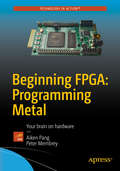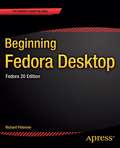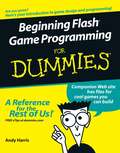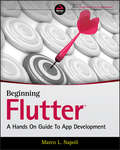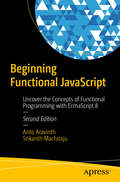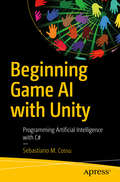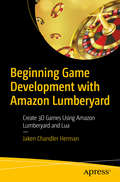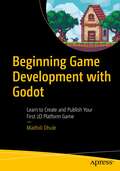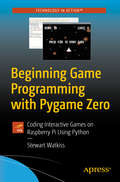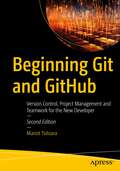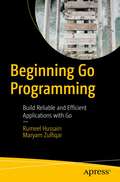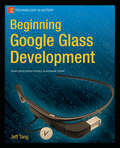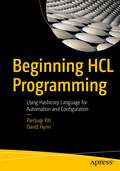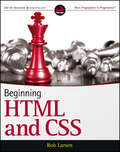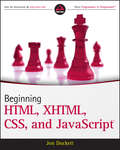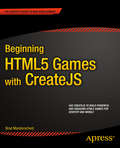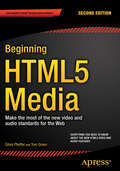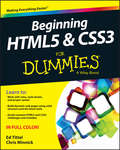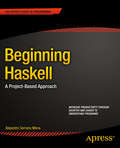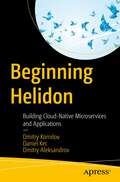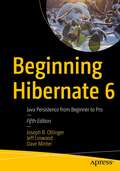- Table View
- List View
Beginning FPGA: Your brain on hardware
by Peter Membrey Aiken PangUse Arrow's affordable and breadboard-friendly FPGA development board (BeMicro MAX 10) to create a light sensor, temperature sensor, motion sensor, and the KITT car display from Knight Rider. You don't need an electronics engineering degree or even any programming experience to get the most out of Beginning FPGA: Programming Metal. Just bring your curiosity and your Field-Programmable Gate Array. This book is for those who have tinkered with Arduino or Raspberry Pi, and want to get more hands-on experience with hardware or for those new to electronics who just want to dive in. You'll learn the theory behind FPGAs and electronics, including the math and logic you need to understand what's happening - all explained in a fun, friendly, and accessible way. It also doesn't hurt that you'll be learning VHDL, a hardware description language that is also an extremely marketable skill. What You'll Learn: Learn what an FPGA is and how it's different from a microcontroller or ASIC Set up your toolchain Use VHDL, a popular hardware description language, to tell your FPGA what to be Explore the theory behind FPGA and electronics Use your FPGA with a variety of sensors and to talk to a Raspberry Pi Who This Book is For: Arduino, Raspberry Pi, and other electronics enthusiasts who want a clear and practical introduction to FPGA.
Beginning Fedora Desktop: Fedora 20 Edition
by Richard PetersenBeginning Fedora Desktop: Fedora 18 Edition is a complete guide to using the Fedora 18 Desktop Linux release as your daily driver for mail, productivity, social networking, and more. Author and Linux expert Richard Petersen delves into the operating system as a whole and offers you a complete treatment of Fedora 18 Desktop installation, configuration, and use. You'll discover how to install Fedora 18 Desktop on any hardware, learn which applications perform which functions, how to managesoftware updates, tips and tricks for the GNOME 3 and KDE desktops, useful shell commands, and both the Fedora administration and network tools. Get the most out of Fedora 18 Desktop -- includingfree Office suites, editors, e-book readers, music and video applications and codecs, email clients, Web and FTP browsers, microblogging and IM applications -- with a copy of Beginning Fedora Desktop: Fedora 18 Edition at your side. "
Beginning Fedora Desktop: Fedora 28 Edition
by Richard PetersenGet the most out of Fedora 28 Desktop, including free Office suites, editors, e-book readers, music and video applications. In addition to those features, you’ll also work with codecs, email clients, web browsers, FTP and BitTorrent clients, VoIP clients, and IM applications. The major Fedora 28 desktop spins are covered in detail, including the Plasma desktop (KDE), Cinnamon, Mate-Compiz, LXDE, Xfce, and LXQT.This is your complete guide to using the Fedora 28 Desktop Linux release as your daily driver for multimedia, productivity, social networking, administrative tasks, and more. Author and Linux expert Richard Petersen delves into the operating system as a whole and offers you a complete treatment of Fedora 28 Desktop configuration and use.With Beginning Fedora Desktop at your side, you’ll discover how to install and update the Fedora 28 Desktop, as well as access various software repositories. You’ll also learn which applications perform which functions, how to manage software, use of the desktop configuration tools, useful shell commands, and both the system administration and network tools.What You'll LearnReview the available desktop choices, including GNOME, KDE, and alternative desktopsAdminister your system, add users, manage printers and perform backupsConfigure network connections and firewalls with FirewallDAccess network resources with SambaWho This Book Is For Novice to intermediate users who are looking to install Fedora 20 as their primary computing environment.
Beginning Flash Game Programming For Dummies
by Andy HarrisYou can start game programming in a flash Here's how to create five different cool games - no experience necessary! Ever think you could come up with a better computer game? Then this book is for you! No boring programming theory here, just the stuff you need to know to actually make something happen, and all in plain English. Build a brain-teasing math game, go classic with Pong, create monsters and mayhem, and much more. Discover how to * Build and control basic movie clips * Make text appear and change * Generate random numbers * Add sound effects * Create cars and space vehicles that move realistically * Blow up stuff onscreen
Beginning Flutter: A Hands On Guide to App Development
by Marco L. NapoliBuild your first app in Flutter—no experience necessary! Beginning Flutter: A Hands-On Guide to App Development is the essential resource for both experienced and novice developers interested in getting started with Flutter—the powerful new mobile software development kit. With Flutter, you can quickly and easily develop beautiful, powerful apps for both Android and iOS, without the need to learn multiple programming languages or juggle more than one code base. This book walks you through the process step by step. In Flutter, you’ll be working with Dart, the programming language of choice for top app developers. Even if you’re just starting out in your development career, you can learn Dart quickly, eliminating the barrier to entry for building apps. This is a more efficient way to develop and maintain cross-platform mobile apps, and this book makes the process even easier with a teach-by-example approach. Focus on providing quality content by eliminating the need to switch between multiple coding languages Learn the ins and outs of Flutter, including all the frameworks, widgets, and tools available to developers Accelerate your app development pace, keeping all the code for your cross-platform app in a single code base Leapfrog barriers to entry to the mobile software market, creating your first app with no experience necessary The Flutter community is growing rapidly and transforming the way Android and iOS apps get made. Beginning Flutter allows you to get on board with the latest app development technology, giving your mobile development career a big head start.
Beginning Functional JavaScript: Functional Programming with JavaScript Using EcmaScript 6
by Anto AravinthLearn functional programming concepts using JavaScript ES6. You will learn concepts such as currying, partial functions, higher-order functions, and monads.Programming languages have evolved from focusing on procedures to objects and now on function. JavaScript supports functional programming and allows developers to write well-crafted code.What You Will Learn: Master functional programming conceptsIdentify how functions are treated in JavaScriptUnderstand real-world functional libraries and create a functional library that mimics underscore.jsPerform pure-error handling techniques such as functors and monadsDiscover ES6 functional features such as spread operators and generatorsWho This Book Is For: JavaScript developers (or beginners) who want to understand functional programming concepts and the functional nature of the language.
Beginning Functional JavaScript: Uncover the Concepts of Functional Programming with EcmaScript 8
by Anto Aravinth Srikanth MachirajuUnderstand functional programming concepts and the functional nature of the JavaScript language. Starting with an introduction to functional programming concepts, you will learn the key differences between imperative and functional programming. Diving straight into JavaScript functions, you will learn to write them with ES8. Followed by this you will move to higher order functions and learn how 'Function as Data' opens up a world of possibilities. You will then build higher order functions with closures. Arrays will then be introduced, followed by a set of APIs you can use with them. You will learn how to transform one function to another using currying and partial application. The compose function will be discussed in detail, followed by functors and monads. After having an in-depth look at applicative functors, you will learn the new features offered in ES8. The concluding chapters of Beginning Functional JavaScript will show you how to use a functional toolkit to build a small library that allows you to develop web applications, followed by tips on testing your functional code.What You Will Learn Discover functional programming concepts such as string padding and async functionsIdentify how functions are treated in JavaScriptCreate a functional library that mimics Underscore.JSDeep dive into ES8 functional features such as spread operators and generatorsCreate a library that works like the react-redux pattern by following the functional paradigmWho This Book Is ForNovice JavaScript developers.
Beginning Game AI with Unity: Programming Artificial Intelligence with C#
by Sebastiano M. CossuGame developers will use this book to gain a basic knowledge of programming artificial intelligence using Unity and C#. You will not be bored learning the theory underpinning AI. Instead, you will learn by experience and practice, and complete an engaging project in each chapter.AI is the one of the most popular subjects in gaming today, ranging from controlling the behavior of non-player characters to procedural generated levels. This book starts with an introduction to AI and its use in games. Basic moving behaviors and pathfinding are covered, and then you move through more complex concepts of pathfinding and decision making.What You Will LearnUnderstand the fundamentals of AICreate gameplay-based AI to address navigation and decision-making problemsPut into practice graph theory and behavior modelsAddress pathfinding problemsUse the A* algorithm, the deus ex machina of pathfinding algorithmsCreate a mini stealth gameWho This Book Is ForDevelopers and programming enthusiasts with a basic knowledge of Unity and C# who want to understand and master the foundations of artificial intelligence in games
Beginning Game Development with Amazon Lumberyard: Create 3D Games Using Amazon Lumberyard and Lua
by Jaken Chandler HermanCreate stunning 3D games in a short amount of time using Amazon Lumberyard, a free and exciting game development platform. This book is a ground-up, out-of-the-box tutorial on 3D game development and programming with Lua and Amazon Lumberyard with little or no game development experience required. Beginning Game Development with Amazon Lumberyard walks you through the user interface of the Amazon Lumberyard engine; teaches you how to develop detailed terrain using heightmaps, megatextures, weather, and vegetation; and takes you through exporting the game for distribution. The book will show you how to create a player as well as enemies while not getting bogged down with third-party tools for animation or model creation. You will also work with simple physics, colliders, meshes, weather generation, Lua scripting, user interface development, and much more.By the end of the book, you will be able to create many different types of video games using the Amazon Lumberyard engine and even have a completed project ready to release or put in your portfolio.What You Will LearnDiscover the mechanics and terminology of game developmentFamiliarize yourself with the Amazon Lumberyard game engine in detailModify game scripts using the Lua languageDiscover how to optimally structure game layersWho This Book is ForDevelopers, programmers, and would-be game designers who have long wanted to dip their toes into the world of game development but have found other game engines and platforms to have too high a barrier to entry.
Beginning Game Development with Godot: Learn to Create and Publish Your First 2D Platform Game
by Maithili DhuleLearn the fundamentals of Godot by diving headfirst into creating a 2D platformer from scratch. This book is a hands-on, practical guide to developing 2D games using the Godot Engine 3.2.3/3.3, with the help of GDScript. Author Maithili Dhule begins by explaining some basic tools and techniques used to make games, the factors that need to be considered while choosing a game engine, and pointing out the benefits of using Godot. She then walks you through downloading the engine and guides you as you explore key features of its interface. Next, you’ll receive a concise introduction to the basics of GDScript, the main scripting language used in Godot, before moving on to essential topics such as Godot’s node-scene architecture, the interaction of various physics bodies, the creation of game scenes, and writing scripts. As the book progresses, you’ll learn how to create and animate your game character, design the game world, add enemies, and implement a coin-collection system. You’ll also see how the user’s gaming experience can be enhanced through the addition of parallax backgrounds, a title screen, music, and sound effects. Toward the end of the book, you’ll learn how to export your game to different platforms, both mobile and PC, as well as possible avenues for monetizing the game. Throughout the book, theoretical concepts are supplemented with concrete, ready-to-implement examples that you can try out. Upon finishing this book, you’ll be able to make and publish your first 2D platform game. Beginning Game Development with Godot is for game development enthusiasts of all levels interested in creating their own games.What You Will LearnUnderstand the Godot engine and the benefits of using it for game developmentMaster the fundamentals of programming in GDScriptUse the Godot graphical interface to design and animate players, the game world, menus, and various games scenes Create your first 2D game in Godot and publish it to various platforms Who This Book Is ForAspiring game developers who may be new to game development, as well as experts exploring the potential of the Godot Engine.
Beginning Game Programming with Pygame Zero: Coding Interactive Games on Raspberry Pi Using Python
by Stewart WatkissMake fun games while learning to code. Focused on making games rather than teaching programming theory, in this book you're more likely to see code on how gravity affects a missiles trajectory instead of the most efficient way to search through data. Even then the code is kept simple as games should be about playability rather than complex physics. There are links to the official documentation when you need to lookup information that isn't included in the book.Start with a simple text based game to grasp the basics of programming in Python. Then moves on to creating simple graphical games in Pygame Zero. Not only will you learn object oriented programming to make it easier to make more complex games, you'll also work to create your own graphics and sounds. 3D graphics are a little complex. So we focus on 2D games, including spins on some classic boardgames and arcade games. All the games are designed to run on a Raspberry Pi. They will work on any Raspberry Pi, but will also work on any other computer that supports Python 3 along with Pygame Zero.The games you make will be playable and hopefully fun to play. And by the end of the book, you can step beyond the provided source code to develop your own unique games and programs.What You'll LearnCode in PythonGenerate sounds and graphics for 2D gamesGrasp object oriented programming with Pygame Zero Who This Book Is ForBeginning game developers interested in working with low-cost and easy-to-learn solutions like Pygame Zero and the Raspberry Pi.
Beginning Git and GitHub: A Comprehensive Guide to Version Control, Project Management, and Teamwork for the New Developer
by Mariot TsitoaraLearn the fundamentals of version control through step-by-step tutorials that will teach you the ins-and-outs of Git. This book is your complete guide to how Git and GitHub work in a professional team environment. Divided into three parts – Version Control, Project Management and Teamwork – this book reveals what waits for you in the real world and how to resolve the problems you may run into. Once past the basics of Git, you'll see how to manage a software project, and finally how to utilize Git and GithHub to work effectively as a team. You'll examine how to plan, follow and execute a project with GitHub, and then apply those concepts to real-world situations. Workaround the pitfalls that most programmers fall into when driving a project with Git by using proven tactics to avoid them. You will also be taught the easiest and quickest ways to resolve merge conflicts. A lot of modern books on Git don’t go into depth about non-technical topics. Beginning Git and GitHub will help you cover all the bases right at the start of your career.What You'll LearnReview basic and advanced concepts of GitApply Project Management skills using GitHub Solve conflicts or, ideally, avoid them altogetherUse advanced concepts for a more boosted workflowWho This book Is For New developers, developers that have never worked in a team environment before, developers with basic knowledge of Git or GitHub, or anyone who works with text documents.
Beginning Git and GitHub: Version Control, Project Management and Teamwork for the New Developer
by Mariot TsitoaraLearn the fundamentals of version control through step-by-step tutorials that will teach you the ins-and-outs of Git. This updated version introduces Github workflows, and contains new chapters on how to make Git and GitHub truly yours, covers additional common problems and how to solve them, along with new features of Github pull requests. Divided into three parts – Version Control, Project Management and Teamwork – this book reveals what waits for you in the real world and how to resolve the problems you may run into. Once past the basics of Git, you'll see how to manage a software project, and finally how to utilize Git and GithHub to work effectively as a team. You'll examine how to plan, follow and execute a project with GitHub, and then apply those concepts to real-world situations. Workaround the pitfalls that most programmers fall into when driving a project with Git by using proven tactics to avoid them. You will also be taught the easiest and quickest ways to resolve merge conflicts. A lot of modern books on Git don’t go into depth about non-technical topics. Beginning Git and GitHub is your complete guide to how Git and GitHub work in a professional team environment and will help you cover all the bases right at the start of your career. What You'll Learn Review basic and advanced concepts of GitApply Project Management skills using GitHub Solve conflicts or, ideally, avoid them altogether Use advanced concepts for a more boosted workflow Who This book Is For New developers, developers that have never worked in a team environment before, developers with basic knowledge of Git or GitHub, or anyone who works with text documents.
Beginning Go Programming: Build Reliable and Efficient Applications with Go
by Rumeel Hussain Maryam ZulfiqarUnderstand and write programs in Go, a multi-paradigm language with built-in features for concurrent programming. This book enables developers to build software that is simple, reliable, and efficient. It'll also help beginners to start programming Go-based applications.Beginning Go Programming begins by explaining the programming fundamentals of the Go language, including basic syntax, data type and structures, and the use of functions and methods. Next, it covers string formatting, Unicode data handling, and how to use regular expressions in Go. Further, it discusses how to encode and decode JSON formatted data for Go applications, and how to work with HTTP in Go. It concludes by exploring concurrency and covering the most powerful features of Go, as well as tips and tricks related to it. After reading this book and working through its practical examples, you will be ready to begin programming your own Go-based applications.What You Will LearnUnderstand the fundamentals of the Go programming languageMaster the different features of Go and how to implement real-life scenarios using the languageWork with text in Go, such as string formatting and Unicode data handlingWork with HTTP in GoWho This Book Is ForProgrammers and developers looking to learn Go programming language concepts for efficient application building.
Beginning Google Glass Development
by Jeff TangBeginning Google Glass Development is your number one resource for learning how to develop for Google Glass--the paradigm-shifting mobile computing platform taking the world by storm now and for years to come. Mobile developers have always had to think for the future, and right now that means getting started with Google Glass. This book is incredibly hands-on with many exciting projects. You will learn the basics of Glass and how to set up your development environment, through to every Glass development topic using Glass Development Kit (GDK): * Glass User Interface * Camera and Image Processing * Video: Basics and Applications * Voice and Audio * Network, Bluetooth, and Social * Locations, Map, and Sensors * Graphics, Animation, and Games You will also learn how to develop enterprise and web-based Glass apps using the Mirror API. Each topic is full of examples that illustrate what Glass can truly do and help you quickly start developing your own apps. Jeff Tang has successfully developed mobile, web, and enterprise apps on many platforms, and cares immensely about user experience. He brings his vast knowledge to this book through cool and practical examples, which will excite and tantalize your creativity. This book is for any developer who is keen to start developing for Glass with GDK or the Mirror API. Whether you are an Android, iOS, web, or enterprise developer, you do not want to miss the chance that Glass becomes the next big thing. Get started with Beginning Google Glass Development and be inspired today. What you'll learn * Glass User Interface * Camera and Image Processing * Video: Basics and Applications * Voice and Audio * Network, Bluetooth, and Social * Locations, Map, and Sensors * Graphics, Animation, and Games Who this book is for This book is for any developer who is keen to start developing for Glass. You may have worked with iOS apps, Android apps, or both - but you can start developing with Glass today using this book. Table of Contents 01 - Getting Started 02 - Hello Glass! Your First GDK Glassware 03 - Glass User Interface 04 - Camera and Image Processing 05 - Video: Basics and Applications 06 - Voice and Audio 07 - Networking, Bluetooth, and Social 08 - Locations, Maps, and Sensors 09 - Graphics, Animations, and Games 10 - The Mirror API (The Mirror API and Enterprise Apps)
Beginning GraphQL: Fetch data faster and more efficiently whilst improving the overall performance of your web application
by Brian KimokotiOver-fetching and under-fetching data can negatively impact the performance of your web application. Future-proof your API structure and handle key development requirements by correctly defining types and schemas in GraphQL.Key FeaturesIncludes server-side implementations using GraphQL.js, Apollo, Graphcool, and PrismaUnderstand an example client-side implementation of GraphQL in ReactJS using ApolloImplement over 20 practical activities and exercises across 5 topics that enable you to efficiently use GraphQL in production Book DescriptionThough fairly new, GraphQL is quickly rising in popularity when it comes to API development. This book will teach you everything you need to know to start building efficient APIs with GraphQL. You’ll begin by learning to create a simple scaffold application using Node.js and Express. Then, you’ll explore core GraphQL concepts and study how GraphQL integrates with other frameworks in real-life business applications. By the end of the book, you will be able to successfully create efficient client-server REST-like applications.What you will learnUnderstand core GraphQL concepts that can be used across different languagesUnderstand the overall structure of GraphQL applicationsUse Apollo GraphQL for both server and client JavaScript applicationsUnderstand the key differences between GraphQL and RESTWho this book is forThis book is ideal for developers who want to broaden their understanding of API development. Prior experience to JavaScript is required, with any prior work with React or Node.js being beneficial.
Beginning HCL Programming: Using Hashicorp Language for Automation and Configuration
by Pierluigi Riti David FlynnGet started with programming and using the Hashicorp Language (HCL). This book introduces you to the HCL syntax and its ecosystem then it shows you how to integrate it as part of an overall DevOps approach. Next, you’ll learn how to implement infrastructure as code, specifically, using the Terraform template, a set of cloud infrastructure automation tools. As part of this discussion, you’ll cover Consul, a service mesh solution providing a full-featured control plane with service discovery, configuration, and segmentation functionality. You’ll integrate these with Vault to build HCL-based infrastructure as code solutions. Finally, you’ll use Jenkins and HCL to provision and maintain the infrastructure as code system. After reading and using Beginning HCL Programming, you'll have the know-how and source code to get started with flexible HCL for all your cloud and DevOps needs. What You Will Learn Get started with programming and using HCL Use Vault, Consul, and Terraform Apply HCL to infrastructure as code Define the Terraform template with HCL Configure Consul using HCL Use HCL to configure Vault Provision and maintain infrastructure as code using Jenkins and HCL Who This Book Is For Anyone new to HCL but who does have at least some prior programming experience as well as knowledge of DevOps in general.
Beginning HTML and CSS
by Rob LarsenEverything you need to build websites with the newest versions of HTML and CSSIf you develop websites, you know that the goal posts keep moving, especially now that your website must work on not only traditional desktops, but also on an ever-changing range of smartphones and tablets. This step-by-step book efficiently guides you through the thicket. Teaching you the very latest best practices and techniques, this practical reference walks you through how to use HTML5 and CSS3 to develop attractive, modern websites for today's multiple devices. From handling text, forms, and video, to implementing powerful JavaScript functionality, this book covers it all.Serves as the ultimate beginners guide for anyone who wants to build websites with HTML5 and CSS3, whether as a hobbyist or aspiring professional developerCovers the basics, including the different versions of HTML and CSS and how modern websites use structure and semantics to describe their contentsExplains core processes, such as marking up text, images, lists, tables, forms, audio, and videoDelves into CSS3, teaching you how to control or change the way your pages look and offer tips on how to create attractive designsExplores the jQuery library and how to implement powerful JavaScript features, such as tabbed content, image carousels, and moreGet up to speed on HTML5, CSS3, and today's website design with this practical guide. Then, keep it on your desk as a reference!
Beginning HTML, XHTML, CSS, and JavaScript®
by Jon DuckettAn indispensable introductory guide to creating web pages using the most up-to-date standards This beginner guide shows you how to use XHTML, CSS, and JavaScript to create compelling Web sites. While learning these technologies, you will discover coding practices such as writing code that works on multiple browsers including mobile devices, how to use AJAX frameworks to add interactivity to your pages, and how to ensure your pages meet accessible requirements. Packed with real-world examples, the book not only teaches you how to write Web sites using XHTML, CSS and JavaScript, but it also teaches you design principles that help you create attractive web sites and practical advice on how to make web pages more usable. In addition, special checklists and appendices review key topics and provide helpful references that re-enforce the basics you've learned. Serves as an ideal beginners guide to writing web pages using XHTML Explains how to use CSS to make pages more appealing and add interactivity to pages using JavaScript and AJAX frameworks Share advice on design principles and how to make pages more attractive and offers practical help with usability and accessibility Features checklists and appendices that review key topics This introductory guide is essential reading for getting started with using XHTML, CSS and JavaScript to create exciting and compelling Web sites. Note: CD-ROM/DVD and other supplementary materials are not included as part of eBook file.
Beginning HTML5 Games with CreateJS
by Brad ManderscheidBeginningHTML5 Games with CreateJS provides a hands-on approach to get you up and running withthe most comprehensive tools available for HTML5 Canvas game development. Whether you are brand new to making games or an experienced game developer, youOCOll learn to fully utilize the CreateJS suite to bring your new or existinggame techniques to desktop and mobile devices. Thisbook covers everything from creating graphics in HTML5 Canvas, to capturinguser input (whether from keyboard, mouse, or touch), to using a state machinefor efficient game control. There are practical (and fun) examples throughoutthe book, with four full game projects, including a mobile RPG. The book alsocovers optimizing your games for mobile and publishing them to app stores. HTML5games are growing more and more popular, and the demand for HTML5 Canvas skillsis on the rise. The CreateJS suite is a powerful toolset that will help youmanage Canvas drawing and animations, asset loading, sound management, complextweening, and much more. Using these robust libraries, you can build powerfuland engaging games that reach a wide range of audiences and devices. "
Beginning HTML5 Media: Make the most of the new video and audio standards for the Web
by Silvia Pfeiffer Tom GreenBeginning HTML5 Media, Second Edition is a comprehensive introduction to HTML5 video and audio. The HTML5 video standard enables browsers to support audio and video elements natively. This makes it very easy for web developers to publish audio and video, integrating both within the general presentation of web pages. For example, media elements can be styled using CSS (style sheets), viewed on a mobile device, and manipulated in a Canvas or an audio filter graph. The book offers techniques for providing accessibility to media elements, enabling consistent handling of alternative representations of media resources. The update includes all of the changes and revisions since the first HTML5 draft. Beginning HTML5 Media dives deep into the markup that is introduced for media element support in browsers. You'll explore the default user interface offered through browsers for media elements, as well as the JavaScript API provided to control their behavior. You'll also learn how to account for H. 264, WebM and Ogg Theora codecs as well as explore the emerging Web Audio API standard, which provides an extensive set of hardware-accelerated audio filters to achieve a level of audio signal manipulation in the browser previously only available to audio professionals. What you'll learn How to create cross-browser markup in HTML to include audio and video into your web pages How to replace the default controls of web browsers with your own or "skin" your media player How to use the JavaScript API for media elements How to integrate media elements with other HTML5 constructs such as CSS, Canvas, or Web Worker Threads How to make audio and video accessible How to use media fragment URIs to address certain temporal subparts or tracks of a media resource How to work with the Web Audio API Who this book is for This book is for those who are proficient in authoring and publishing Web pages, but have never utilized audio and video. It will also help those proficient in the use of Adobe Flash, Microsoft Silverlight, or QuickTime to understand what is happening in HTML5 media and how to use the new media elements. Table of Contents 1. Encoding Media 2. Using and Manipulating Media Elements 3. The JavaScript API 4. Accessibility and Internationalization of HTML5 Media 5. Manipulating Media via Canvas 6. Manipulating Audio Through the WebAudio API
Beginning HTML5 and CSS3 For Dummies
by Ed Tittel Chris MinnickYour full-color, friendly guide to getting started with HTML5 and CSS3!HTML and CSS are essential tools for creating dynamic websites and help make your websites even more effective and unique. This friendly-but-straightforward guide gets you started with the basics of the latest versions of HTML and CSS: HTML5 and CSS3. Introducing you to the syntax and structure of the languages, this helpful guide shows you how to create and view a web page, explains ideal usage of HTML5 and CSS3, walks you through the CSS3 rules and style sheets, addresses common mistakes and explains how to fix them, and explores interesting HTML5 tools.Serves as an ideal introduction to HTML5 and CSS3 for beginners with little to no web development experienceDetails the capabilities of HTML5 and CSS3 and how to use both to create responsive, practical, and well-designed websitesHelps you understand how HTML5 and CSS3 are the foundation upon which hundreds of millions of web pages are builtFeatures full-color illustrations to enhance your learning processBeginning HTML5 and CSS3 For Dummies is the perfect first step for getting started with the fundamentals of web development and design.
Beginning Haskell: A Project-Based Approach
by Alejandro Serrano MenaBeginning Haskell provides a broad-based introduction to the Haskell language, its libraries and environment, and to the functional programming paradigm that is fast growing in importance in the software industry. The book takes a project-based approach to learning the language that is unified around the building of a web-based storefront. Excellent coverage is given to the Haskell ecosystem and supporting tools. These include the Cabal build tool for managing projects and modules, the HUnit and QuickCheck tools for software testing, the Scotty framework for developing web applications, Persistent and Esqueleto for database access, and also parallel and distributed programming libraries. Functional programming is gathering momentum, allowing programmers to express themselves in a more concise way, reducing boilerplate and increasing the safety of code. Indeed, mainstream languages such as C# and Java are adopting features from functional programming, and from languages implementing that paradigm. Haskell is an elegant and noise-free pure functional language with a long history, having a huge number of library contributors and an active community. This makes Haskell the best tool for both learning and applying functional programming, and Beginning Haskell the perfect book to show off the language and what it can do. Takes you through a series of projects showing the different parts of the language. Provides an overview of the most important libraries and tools in the Haskell ecosystem. Teaches you how to apply functional patterns in real-world scenarios. What you'll learn Build small and large projects using the Haskell language. Profit from ecosystem tools such as Cabal, HLint, and QuickCheck. Implement efficient stream I/O via libraries like Conduit. Parallelize code to run on multiple processors or distributed across a network. Create domain-specific languages useable by business users, and to tackle specific problem domains. Build Haskell-backed websites using database and web-application libraries such as Persistent, Esqueleto, and Scotty Who this book is for Beginning Haskell is for programmers new to functional programming, who want to learn this new paradigm and how it can improve the quality of their code. Beginning Haskell is also a great choice for functional programmers wanting to get a taste of the Haskell ecosystem and its unique features, or who wish to learn about advanced type system features and patterns. Table of Contents Part I: First Steps 1. Going Functional 2. Declaring the Data Model 3. Reusing Code through Lists 4. Using Containers and Type Classes 5. Laziness and Infinite Structures Part II: Data Mining 6. Knowing Your Clients Using Monads 7. More Monads: Now for Recommendations 8. Parallelizing the Execution Part III: Resource Handling 9. Dealing with Files: IO and Conduit 10. Builders and Parsers 11. Safe Database Access 12. Web Applications Part IV: Domain Specific Languages 13. Strong Types 14. Attribute Grammars Part V: Engineering the Store 15. Documenting, Testing, and Verifying 16. Architecting Your Application Appendix A Appendix B
Beginning Helidon: Building Cloud-Native Microservices and Applications
by Dmitry Kornilov Daniel Kec Dmitry AleksandrovLearn how to build cloud-native microservices with Helidon - an open-source Java framework from Oracle. This book will show you how to take full advantage of the cloud by optimizing applications with fast start times, low memory consumption, and a small disk footprint. The open-source Helidon framework provides all that, and more. It’s based on Java 17, giving you full access to new code features. This book reveals how Helidon also supports modern enterprise Java standards such as MicroProfile. Plus, you'll see how Helidon lets you use GraalVM to build lightning-fast native executables, and its unique reactive layer allows you to develop efficient low-level APIs.Each chapter in the book teaches a new Helidon concept through practical examples based on real-life use-cases. You’ll learn how to add observability and security to your microservices, how to work with databases, and call other services. You'll also look at all MicroProfile 5.0 platform specifications as well as some stand-alone specs such as Messaging and Long Running Actions. Best of all, everything covered in this book makes it a great study guide for the upcoming Oracle Helidon certification - the perfect way to prove your new skills to a prospective employer!What You'll LearnPackage microservices using JLink and GraalVMDeploy microservices to Kubernetes Review MicroProfile 5.0 specifications in detailUnderstand the basics of Helidon Reactive APIsWho This Book Is ForDevelopers and architects who want to start developing cloud-native applications; developers who already use different Java framework and want to learn about Helidon; those interested in developing portable applications using MicroProfile and Jakarta EE
Beginning Hibernate 6: Java Persistence from Beginner to Pro
by Joseph B. Ottinger Dave Minter Jeff LinwoodGet started with Hibernate, an open source Java persistence layer and gain a clear introduction to the current standard for object-relational persistence in Java. This updated edition includes the new Hibernate 6.0 framework which covers new configuration, new object relational mapping changes, and enhanced integration with the more general Spring, Boot and Quarkus and other Java frameworks.The book keeps its focus on Hibernate without wasting time on nonessential third-party tools, so you’ll be able to immediately start building transaction-based engines and applications. Experienced authors Joseph Ottinger with Dave Minter and Jeff Linwood provide more in-depth examples than any other book for Hibernate beginners. They present their material in a lively, example-based manner—not a dry, theoretical, hard-to-read fashion.What You'll LearnBuild enterprise Java-based transaction-type applications that access complex data with HibernateWork with Hibernate 6 using a present-day build processIntegrate into the persistence life cycleSearch and query with the new version of HibernateKeep track of versioned data with Hibernate EnversWho This Book Is ForProgrammers experienced in Java with databases (the traditional, or connected, approach), but new to open-source, lightweight Hibernate.
